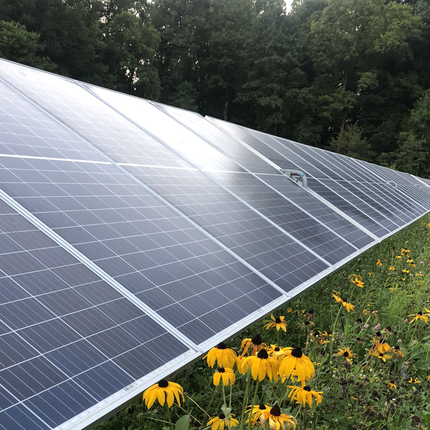By Cody Smith, former staff member | Published in the Cedar Rapids Gazette on May 10
For decades Iowans have led the nation in innovating our way to a cleaner, more reliable power grid that promotes public health and economic prosperity in our rural communities. Now, as we celebrate hitting the milestone of producing nearly 60 percent of our electricity with renewable wind energy, Iowa’s solar industry is also booming and bringing our rural economies along with it.
Solar offers a way for Iowa’s local entrepreneurs to slash their energy costs and refocus resources on expanding businesses that line main streets in small towns statewide. When Iowa’s businesses save money on their energy costs with solar, they can hire more employees, sell more goods and services, and invest in the communities they serve. The economics of solar are clear and present in rural towns across the state, just take a look out the window next time you drive through your local business district.
Meanwhile, solar energy empowers farmers to improve their bottom lines and promote economic prosperity for operations of all sizes. By farming the sun, producers are harvesting another commodity to power their ventilation fans and grain drying equipment, saving them thousands of dollars, especially during corn years when drying the grain for safe storage increases demand.
As more farmers and small businesses harness solar energy to cut costs, Iowa’s workforce is expanding to include hundreds of 21st century clean energy jobs. In fact, in 2020, Iowa’s solar industry had grown to include nearly 900 jobs, according to the Solar Energy Industries Association. Meanwhile, the workforce is expanding as the demand for renewable solar energy compounds job growth at the 85 Iowa-based supply chain businesses including solar installers and developers.
But, as the demand has grown, one thing has become evident — Iowa’s policies are standing in the way of our clean energy future.
A clear signal of the demand, Iowa’s solar tax credit — which is capped at $5,000 for residential projects and $20,000 for commercial projects — has been oversubscribed since 2015. Currently, the waiting list for the tax credit is about two years, meaning farmers, small business owners, and homeowners who invested in solar energy will have to wait until 2023 to claim their credit.
Thankfully, lawmakers have the opportunity to fix this issue by passing House File 221 and bolster Iowa’s position as a clean energy leader. In addition to clearing out the backlog of solar customers waiting to receive their credit, the bill would double the state-mandated cap of $5 million and set the tax credit at 15 percent of project costs until it sunsets in 2030.
In addition to putting Iowa’s farmers, small business owners, and the communities they serve on a path to a brighter solar future, House File 221 would decouple Iowa’s credit from the federal investment tax credit, reclaiming our state’s ability to plot its own path forward.
Looking forward, Iowa’s leaders have the opportunity to ensure the state’s rural communities are on a prosperous path as we write the next chapter of our clean energy legacy.
Feature photo provided by the Center for Pollinators in Energy





